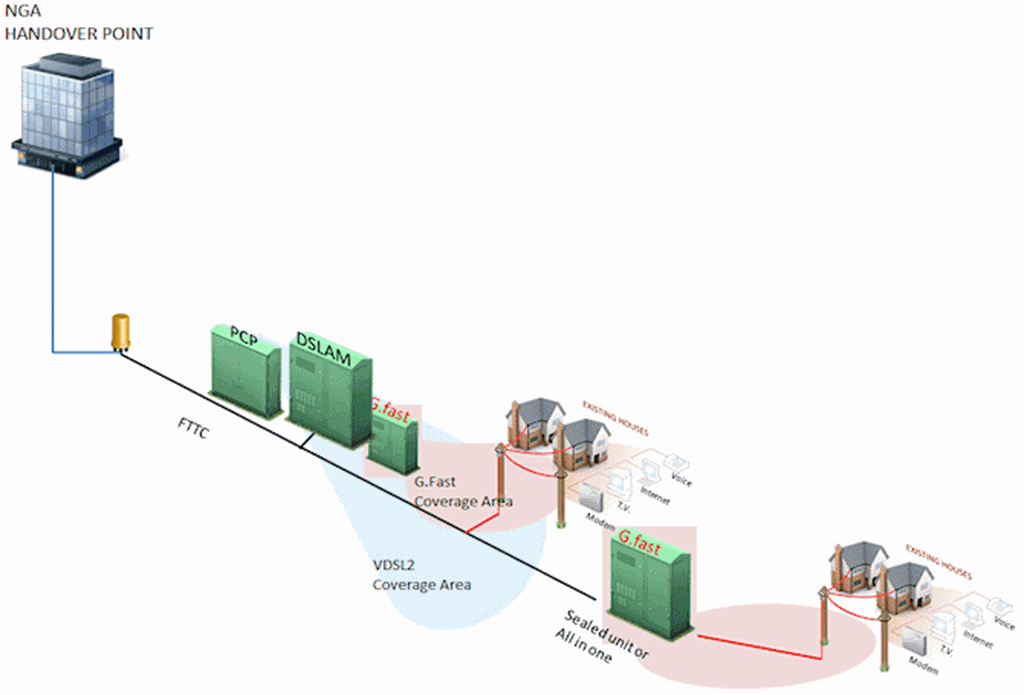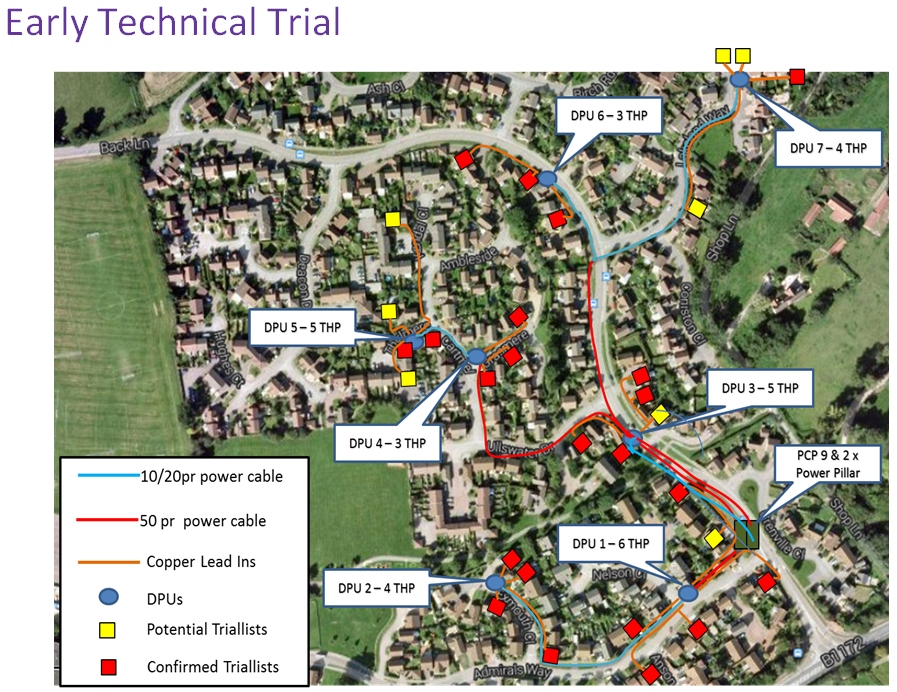UPDATE2 BT Confirm Third 500Mb UK G.fast Broadband Pilot Set for Swansea
Earlier this year BT announced a decade long deployment plan for their next generation G.fast (ITU G.9701) broadband technology (details), which will begin in 2016/17 and should eventually make download speeds of ‘up to’ 500Mbps available to “most homes” across the United Kingdom.
As a quick recap, G.fast works in a loosely similar way to the operators current ‘up to’ 80Mbps Fibre-to-the-Cabinet (FTTC) technology, except that it requires significantly more radio spectrum (FTTC = 17MHz vs G.fast 106MHz+) and must thus operate over a much shorter run of copper cable (ideally less than 200 metres).
Advertisement
Due to this the high capacity fibre optic line has to be taken even closer to homes, usually as far as a smaller remote node or distribution point (FTTdp / FTTrN) that can be built on top of a telegraph pole, inside a street cabinet or possibly even put underground.
In an ideal setup it’s predicted that a home with a G.fast node right outside, and no existing VDSL2 (FTTC) services to gobble part of the shared spectrum, might be able to achieve top speeds of approaching 1000Mbps; although BT has wisely avoided promising such performance (even if they could deliver it, the capacity demands might be a problem).

BT had originally announced that its commercial roll-out would be proceeded by two Summer 2015 pilots, one in Huntingdon (Cambridgeshire) and another in Gosforth (Newcastle). Each of these would involve around 2,000 premises (total of 4,000).
Advertisement
However today also saw BT’s Chief Network Architect, Neil McRae, give a speech at the UK Network Operators Forum (UKNOF) in Manchester, where he released a few slivers of new information to the public.
The speech included the above diagram and a few details about another “Early Technical Trial” that the operator had conducted (see below for a useful overview of BT’s deployment strategy), which suggested that initially you’ll probably have to live within around 50 metres of a G.fast distribution point in order to receive 500Mbps. All of this in roughly in keeping with what we already know from BT’s even earlier prototype trial (details here and here).

But the most interesting bit of information to come out of Neil’s speech was that the operator now plans for a third trial to take place during the summer, which will be conducted somewhere in the city of Swansea (Wales). The suggestion is that this too would involve 2,000 premises.
Advertisement
BT also suggested that the stated speed of 500Mbps might not be what the operator actually offers at launch. Mr McRae said, “[G.fast] will initially provide hundreds of megabits, rising up to 500Mbps within ten years. … We are aggressively pursuing further industry standards to improve the rate vs reach of G.fast and enable new kit to be developed.” The trials will likely mirror Openreach’s current top FTTP speed of around 300Mbps, although this may not reflect the commercial launch product.
At this stage it’s still too early to say precisely what approach BT will take to G.fast deployment, such as with regards to the target distribution point distance (note: most of their early trials seem to set an upper limit of around 100 metres) and how they’ll manage G.fast’s coexistence with VDSL2 / FTTC services in the same area because the two share some of the same spectrum.
One tricky solution would be to automatically upgrade lines to G.fast as it goes live, as opposed to tolerating a lower speed with FTTC coexistence (initially we suspect they’ll allow the two to work side-by-side and accept a loss of top G.fast performance). Another problem is that some Sub-Loop Unbundled (SLU) ISPs with their own FTTC deployments are unlikely to benefit due to incompatible G.fast hardware, although we doubt BT will lose sleep over that.
We hope to have more details on the summer trials in a few months. The trials will represent the first time that BT has taken G.fast out of a more controlled environment and deployed it using commercial grade hardware. As such we’re keen to see how it performs once subjected to the mucky real-world.
UPDATE 21st April 2015
BT informs that the Swansea trial is not, contrary to the slides, the same size (2,000 residential premises) as the other two areas because it will be a technical rather than residential trial. The operator has also furnished us with a statement.
A BTOpenreach spokesperson told ISPreview.co.uk:
“We are looking at the possibility of conducting a technically-focused G.fast trial in Swansea, drawing on our expertise and experience in South Wales, rather than a large-scale residential trial. We will reveal more details in due course.”
UPDATE 21st April 2015 – 3:32pm
Sadly it looks as if the Powerpoint slides have been taken offline, so we’ll paste in some of its other details from our copy below for future reference. Firstly, BT said that they have identified 5 key developments required to deliver their ambition for future copper broadband services (G.fast):
* Enable higher bits per tone
* Improve the receiver sensitivity (Noise floor)
* Increase the transmit power
* Optimise the frequency usage with VDSL
* Increased vectoring group sizes
The slides also included mention of how the above trials would also involve some testing of new fibre optic deployment methods and a revised approach to Fibre on Demand (FoD / FTTP on Demand). Apparently a pilot is already live in Thornton Heath (London) with “positive feedback”.
Using easier to deploy cable
* Push/Pull instead of [blown fibre]. SST versus tube
* Fast Access Cable – Peels like a banana
* Less issues at customer site with splicing and presentation.
* Testing easier
As one of our readers (MikeW) appears to have correctly pointed out, the Push/Pull approach most likely refers to fibre being blown with a leading piston/missile that adds the “pull” element, alongside a standard “push” given by a fibre-blowing machine.
Mark is a professional technology writer, IT consultant and computer engineer from Dorset (England), he also founded ISPreview in 1999 and enjoys analysing the latest telecoms and broadband developments. Find me on X (Twitter), Mastodon, Facebook, BlueSky, Threads.net and Linkedin.
« Ofcom Identifies Candidate Spectrum for Future 5G Mobile Broadband

















































Comments are closed